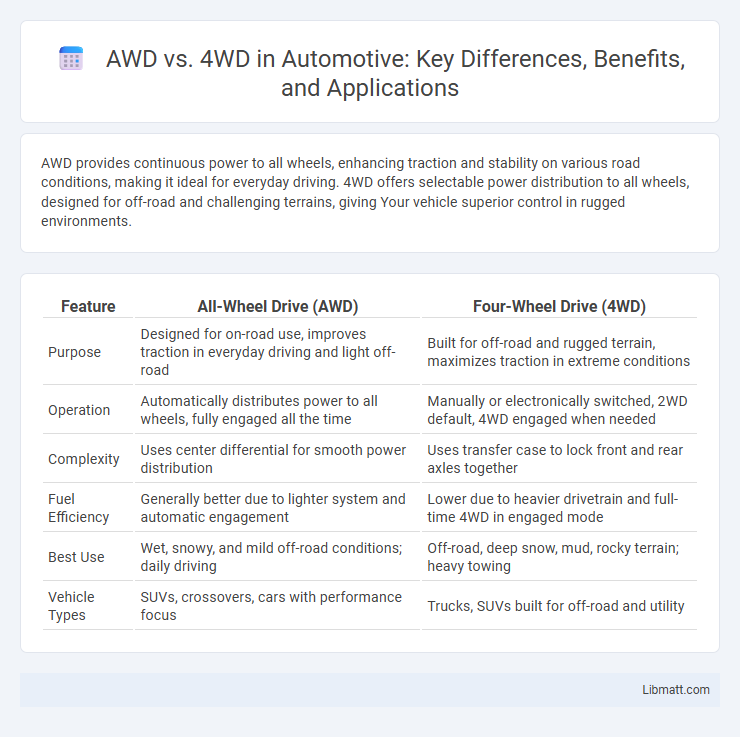AWD provides continuous power to all wheels, enhancing traction and stability on various road conditions, making it ideal for everyday driving. 4WD offers selectable power distribution to all wheels, designed for off-road and challenging terrains, giving Your vehicle superior control in rugged environments.
Table of Comparison
| Feature | All-Wheel Drive (AWD) | Four-Wheel Drive (4WD) |
|---|---|---|
| Purpose | Designed for on-road use, improves traction in everyday driving and light off-road | Built for off-road and rugged terrain, maximizes traction in extreme conditions |
| Operation | Automatically distributes power to all wheels, fully engaged all the time | Manually or electronically switched, 2WD default, 4WD engaged when needed |
| Complexity | Uses center differential for smooth power distribution | Uses transfer case to lock front and rear axles together |
| Fuel Efficiency | Generally better due to lighter system and automatic engagement | Lower due to heavier drivetrain and full-time 4WD in engaged mode |
| Best Use | Wet, snowy, and mild off-road conditions; daily driving | Off-road, deep snow, mud, rocky terrain; heavy towing |
| Vehicle Types | SUVs, crossovers, cars with performance focus | Trucks, SUVs built for off-road and utility |
AWD vs 4WD: Key Differences
All-Wheel Drive (AWD) systems provide continuous power to all wheels, optimizing traction and handling on diverse road conditions, especially on wet or slippery surfaces. Four-Wheel Drive (4WD) systems engage power to all wheels selectively, primarily designed for off-road and rugged terrain, offering superior torque and control in extreme environments. AWD suits everyday driving and varying weather by automatically adjusting power distribution, while 4WD requires manual activation for heavy-duty use and off-road challenges.
How AWD Systems Work
All-Wheel Drive (AWD) systems automatically distribute power to all four wheels, adjusting torque based on traction conditions to maximize grip on varying surfaces. These systems rely on a center differential or electronic clutch to transfer power dynamically between the front and rear axles without driver intervention. Your vehicle benefits from enhanced stability and control, especially in unpredictable weather or off-road conditions, as AWD continuously manages power delivery for optimal performance.
How 4WD Systems Operate
4WD systems operate by distributing power evenly to all four wheels through a transfer case, typically engaging manually or automatically depending on terrain conditions. This setup provides maximum traction and control on off-road or slippery surfaces by locking the front and rear axles together. Your vehicle's 4WD system enhances stability and performance in challenging driving scenarios such as mud, snow, or steep inclines.
Performance on Different Terrains
AWD systems constantly distribute power to all four wheels, providing superior traction on wet, icy, or uneven roads, making them ideal for varying on-road conditions and light off-road use. In contrast, 4WD offers enhanced off-road performance by allowing you to manually engage power to all wheels, delivering maximum torque and control on rugged terrains like mud, rocks, and deep snow. Your choice between AWD and 4WD should depend on the typical terrain you encounter and the level of off-road capability required.
Fuel Efficiency: AWD vs 4WD
AWD systems typically offer better fuel efficiency compared to 4WD due to their lighter weight and ability to engage all-wheel drive only when necessary. 4WD systems are often heavier and designed for off-road use, leading to increased fuel consumption when engaged. Your choice between AWD and 4WD can impact fuel economy depending on driving conditions and vehicle design.
Maintenance and Reliability Comparison
AWD systems generally require less maintenance than 4WD systems due to their simpler design and fewer components, such as lacking a transfer case or manual engagement parts. Reliability in AWD vehicles tends to be higher in daily driving conditions since the system is fully integrated and continuously active, reducing wear caused by user error or neglect. Conversely, 4WD systems, while robust for off-road use, can experience increased maintenance costs over time due to more complex drivetrain components and potential for damage during heavy off-road use.
Cost Differences: Purchase and Upkeep
AWD systems generally cost more upfront due to advanced technology and integrated sensors, but they tend to require less frequent maintenance compared to 4WD systems, which have rugged components designed for off-road use that may need regular servicing. Your total cost of ownership can increase with 4WD because of higher expenses related to drivetrain repairs, such as transfer case and differential maintenance. Choosing AWD often results in lower repair bills and better fuel efficiency, making it a more budget-friendly option for everyday driving.
Best Uses for AWD Vehicles
AWD (All-Wheel Drive) vehicles excel in providing enhanced traction and stability on various road conditions, making them ideal for daily commuting, light off-roading, and adverse weather such as rain or snow. This system continuously distributes power to all four wheels, improving handling and safety on paved surfaces without the need for driver intervention. Your AWD vehicle offers reliable performance for urban driving and moderate outdoor adventures where seamless grip and control are essential.
Best Uses for 4WD Vehicles
4WD vehicles excel in off-road conditions, steep inclines, and rugged terrains where maximum traction and power distribution to all four wheels are essential. Their low-range gearing provides superior control for rock crawling, deep mud, and snow, making 4WD ideal for outdoor adventures and work in challenging environments. You benefit from enhanced durability and stability when driving in remote or difficult terrain that demands consistent traction.
Which Is Right for You: AWD or 4WD?
Choosing between AWD and 4WD depends on your driving needs and terrain. AWD provides seamless power distribution for enhanced traction on wet or slippery roads, ideal for daily commuting and light off-road conditions. 4WD offers robust performance with selectable modes for challenging off-road environments and heavy-duty tasks, making it suitable for rugged terrain and heavy towing.
AWD vs 4WD Infographic

 libmatt.com
libmatt.com